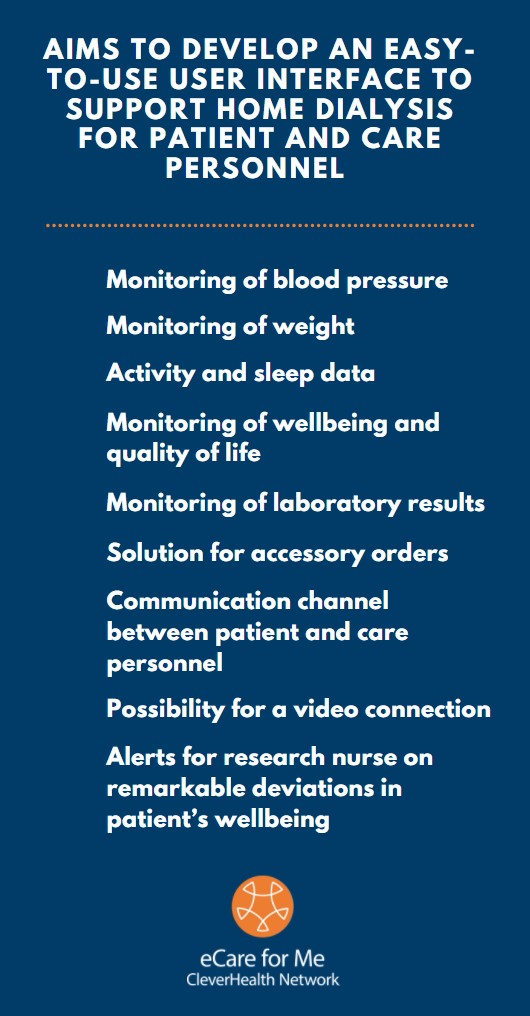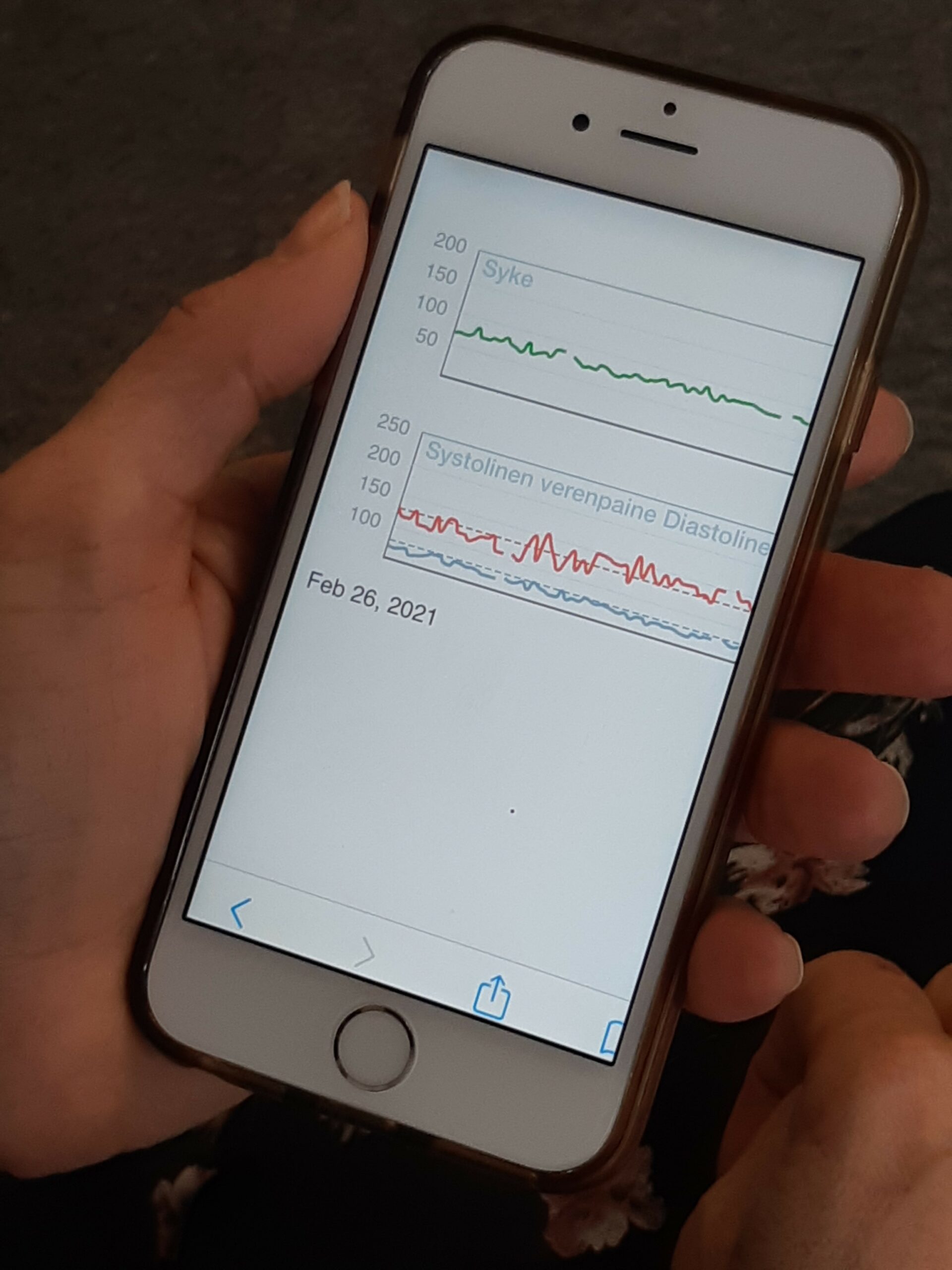To start with, arranging home dialysis is quite a complex process for the patient and care personnel alike, but doing dialysis at home is a remarkable game-changer in the daily life of the patient. The aim of the dialysis project led by Helsinki University Hospital (HUS) is to ease the early detection of patients suited for home dialysis. Further, the project aims to create an application which could be used throughout the predialysis stage until the actual dialysis stage. The research project where the application and its measuring devices are currently being piloted with several patients, is part of the eCare for Me project entity under the CleverHealth Network.
Peritoneal dialysis done at home does not really interfere with Lasse’s daily life
A former HVAC professional, Lasse Hartikainen has been performing peritoneal dialysis at home for more than year and a half. As the dialysis treatment became imminent, Lasse spent a week-long training stint at HUS where he became familiar of the various dialysis options and patients’ dietary recommendations. Lasse’s treatment of choice was peritoneal dialysis done overnight while asleep. Lasse is also able to do a manual peritoneal dialysis, which he can perform at the summer cottage or even at the backseat of a car.
Lasse was given training on peritoneal dialysis and related equipment at HUS, and for his first home dialysis, a designated nurse was by his side to guide him through the process. Since then, Lasse has been independently doing his dialysis, and also orders the required accessories every two weeks. The accessories are delivered home from the pharmacy. Lasse feels that the treatment is quite effortless and does not have a huge impact on his everyday life. In his opinion, the decisive factor for a successful treatment is the open attitude.
User interface helps monitoring patient’s wellbeing between hospital appointments
A former midwife, the research nurse Tiina Puurtinen has been working in this project that aims to make home dialysis practices more efficient and modern for a couple of years now. She explains that currently there are a total of 128 patients in the project, including both predialysis patients and home dialysis patients. The control group also has some hospital dialysis patients. More patients are also being recruited.
Pirgit Silvast-Äikäs is the other research nurse in the project and has worked over 15 years with peroneal dialysis patients. According to her, it can sometimes be somewhat challenging to encourage patients to choose the home dialysis and ensure that their training is at an adequate level. Digital care paths of the Munuaistalo in Health Village already offer new tools for these challenges. They help patients learn about the various stages of different treatment options through videos and verbal instructions, making it easy for the patients to return to them later on if needed.

Patient safety is enhanced in the currently ongoing CleverHealth network project with measurement devices that monitor patient’s wellbeing through an application. As the patient measures their blood pressure and weight daily, the data are automatically registered to an AI-based application and displayed as easy-to-read graphs. The application will alert the research nurses in case there are any remarkable deviations in the wellbeing of the patient. A wellbeing watch is used to monitor patient’s activity levels and sleep quality. Pirgit explains that data related to sleep quality provides important information on patient’s health: increased naps and poor sleep quality may indicate infections or decline in the wellbeing of a predialysis patient. Laboratory tests are stored into the application as well and it acts as a communication channel between patient and research nurse — also usable on a mobile device.
Lasse Hartikainen finds the use of measurement devices quite effortless and monitoring the measurement data has been interesting for himself as well. The user interface brings a sense of security when he knows that the nurses are able to follow his wellbeing also between doctor’s visits. Should there be any issues or questions, the nurse is only a phone of video call away on weekdays.
A more technical home hemodialysis suits an independent patient
Marjatta Tolvanen-Ojutkangas is a pensioner leading an active life. She has been performing home hemodialysis since 2017. Home dialysis was an obvious choice also for her, because a relative is also undergoing the same treatment and she then became familiar with the process. As the home hemodialysis is a more technical treatment option, the patient first needs to spend 4-6 weeks in hospital training. During the training period, a close connection between the nurse and the patient is created. Marjatta says that she has learned to use the equipment “the hard way”, but help has always been at hand. Skilled nurses have been able to solve any issues over a phone of video connection.
Doing home hemodialysis requires some extra courage and independence from the patient. The dialysis device and a pile of accessories do take quite a bit of space at home and some additional installations for electricity, water supply and plumbing are required. Marjatta reminds that the patient also needs agile fingers and cannot shy away from sticking needles into their body. She has in fact become such a skilled needle-user that she prefers to do it herself, also at the occasional hospital dialysis visits.
Marjatta is thankful for HUS that despite her illness, she can lead a relatively normal life. Life is naturally quite scheduled and there is no room for spontaneous trips: over the course of two weeks, the dialysis is performed on 10 days and the whole session takes about four hours each. During her dialysis, Marjatta has time to chat with her friends over the phone, read books, watch tv or take a nap. According to research, dialysis treatments taken more frequently have a positive effect on patient health and pose less drain on the body, so Marjatta prefers home dialysis over hospital dialysis.
Marjatta’s life with home dialysis has gone well and her treatment has not required any additional hospital visits in the past couple of years. After having followed her measurement results on the mobile device and user interface, she comments that the research is taking steps to the right direction to ease the patient’s daily life and is glad to see new technologies being introduced in the process. The weight and blood pressure data taken in connection with the dialysis treatment are automatically transferred to the application. In the future, the rest of the treatment-related data will also be saved in the application without need for duplicate registering.
More information
Project Manager, Anja Kajanne, anja.kajanne[a]hus.fi

